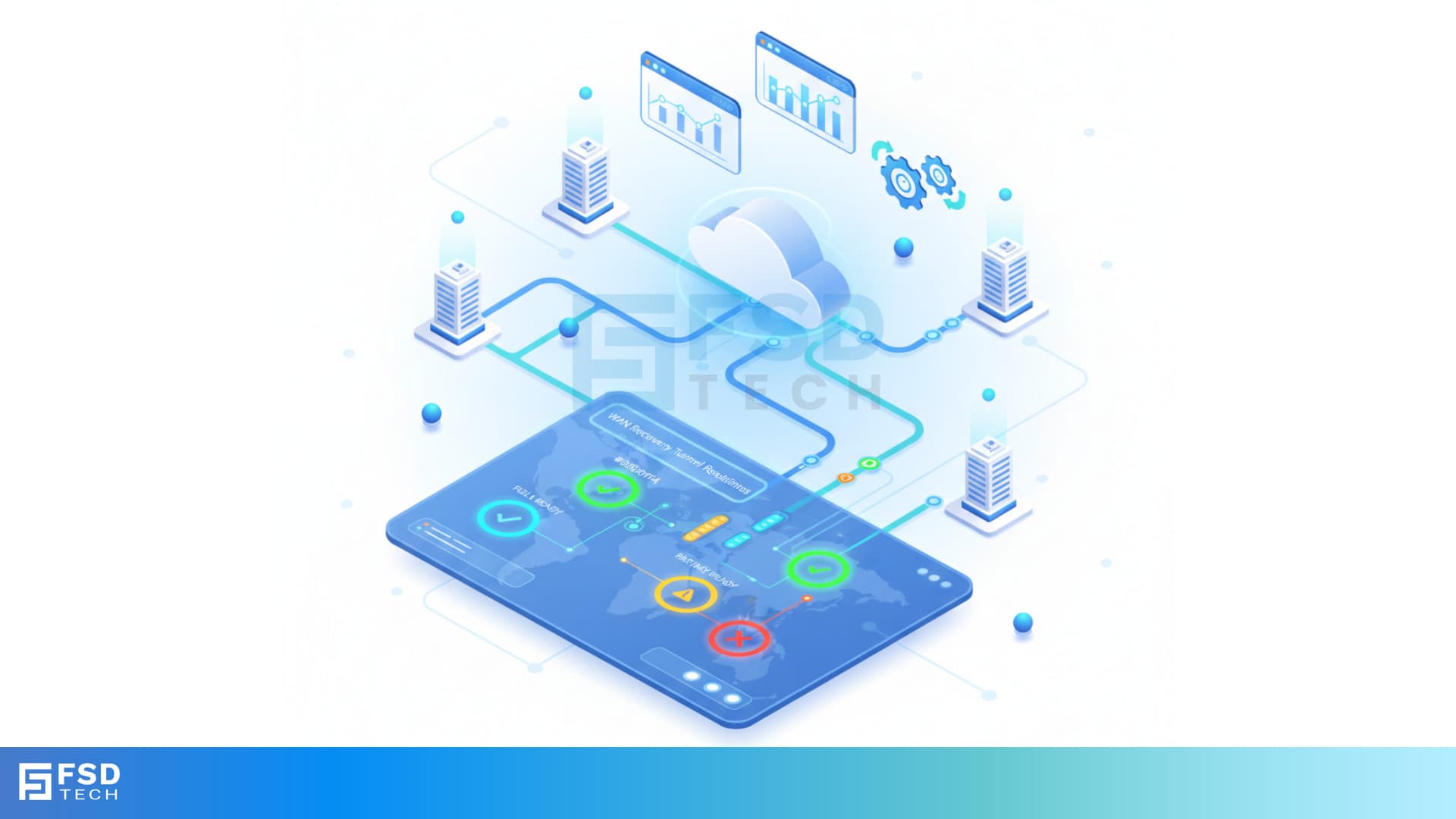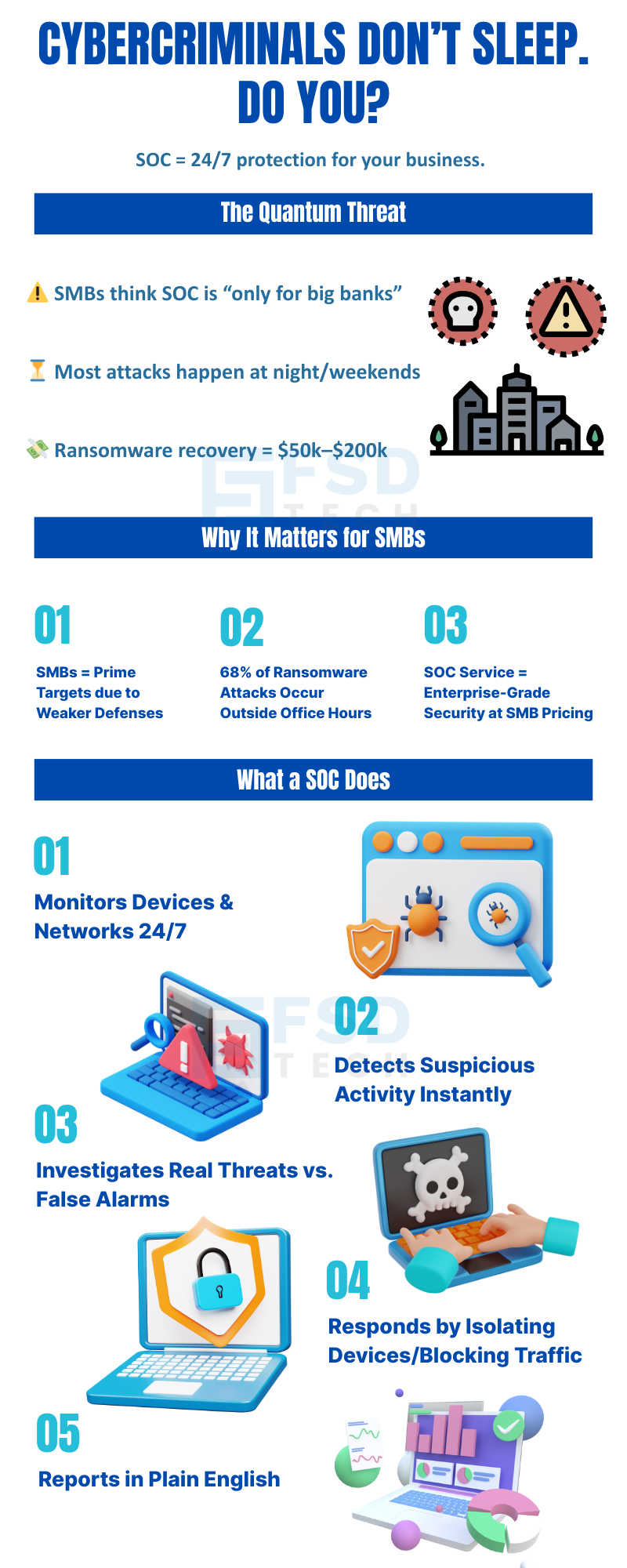
WAN Recovery Tunnel Status in Cato SASE: Readiness You Can See
🕓 September 30, 2025

It’s 2:37 AM on a Thursday.
Your office is dark. Employees are asleep. Your IT technician is home, phone on silent.
But somewhere — maybe in Eastern Europe, Asia, or even inside your own city — a cybercriminal is at work.
They’re testing stolen passwords.
They’re sending fake invoices laced with malware.
They’re probing your systems for weak points.
Or worse — they’re already inside, quietly copying your customer data.
Question: Who’s watching your business right now?
For many SMBs in GCC & Africa, the answer is: nobody.
And that’s exactly why cybercriminals love small and mid-sized businesses. They know you’re unprotected at night, on weekends, and during holidays.
The solution is not hiring an army of IT staff you can’t afford. The solution is having a SOC — a Security Operations Center — watching over your business 24/7.
Think of a SOC as your company’s central command center for cybersecurity.
Inside a SOC, you’ll find:
A SOC’s entire mission is to monitor, detect, investigate, and respond to threats before they cause damage.
Analogy: Imagine you own a retail store. You have CCTV cameras everywhere. But cameras are useless without security guards watching them. The SOC is both your CCTV and your 24/7 security guards — but for your digital assets.
The best part? You don’t need to build one yourself. SOCs are often offered as a service, where expert teams in high-tech facilities protect multiple clients at once. That means you get enterprise-level protection without enterprise-level costs.
To simplify, let’s break it into two main components:
Cybersecurity analysts, engineers, and incident responders who stay awake, so you don’t have to.
Advanced tools that scan for unusual patterns, such as:
It’s like having a firefighter, police officer, and detective all rolled into one team — always on duty.
Many small business leaders still think: “A SOC is only for big companies like banks or governments.”
That’s a dangerous misconception. In fact, SOCs are often more important for SMBs, and here’s why:
Hackers know SMBs don’t have large cybersecurity teams. They see you as “easy prey.” Even if your business is small, your customer data, invoices, and contracts are valuable.
Cybercriminals strike when you’re offline. Without round-the-clock monitoring, a breach might go unnoticed for days — giving attackers plenty of time to steal, encrypt, or destroy.
Hiring a full in-house cybersecurity team is costly. Salaries for experienced analysts in GCC or Africa can reach $70k–$120k annually per person. A SOC service gives you the same skills at a fraction of the cost.
Real Example:
A retail chain in Abu Dhabi thought they were too small to need 24/7 monitoring. A ransomware attack on a Saturday night locked their sales system. By Monday morning, operations were frozen, and they lost AED 150,000 in sales. A SOC could have contained the threat instantly.
Don’t wait until it’s too late — strengthen your defenses with 24/7 SOC monitoring today. Click Here
To make this clear, let’s walk through the S.O.C. process in plain English:
The SOC watches your network, servers, and devices in real time. Every login, file transfer, and system process is checked.
If something looks suspicious — like a login from another country or a sudden mass download — the system raises an alert.
Analysts immediately review the alert to see if it’s a real threat or a false alarm.
If it’s real, action happens fast:
You receive a clear, non-technical report so you understand exactly what happened and how it was resolved.
Think of it as having both security cameras AND guards who stop the intruder before they rob you.
Here are the top 5 threats SMBs in GCC & Africa face — all handled by a SOC:
Fake emails that trick employees into giving away credentials.
Malware that locks your data and demands payment.
Hackers gaining unauthorized access to customer or financial records.
Employees or contractors misusing access, sometimes by mistake, sometimes maliciously.
Brand-new vulnerabilities in software that attackers exploit before patches are released.
Case Study:
A mid-sized healthcare provider in Nairobi faced a phishing attack where staff received fake “insurance renewal” emails. A SOC spotted the unusual logins immediately and blocked access before patient records were stolen.
At FSD-Tech, our SOC combines human expertise with cutting-edge Xcitium technology to give SMBs an unbeatable shield.
Most business leaders underestimate the timing of attacks.
By then, it’s too late: data is stolen, systems are locked, and damage is already done.
Analogy:
Would you lock your office only during the day and leave it open at night? That’s exactly what it’s like to run IT systems without 24/7 monitoring.
Scenario | Without SOC | With SOC |
|---|---|---|
| Ransomware Attack | $50k–$200k in recovery costs | Contained in minutes |
| Phishing Breach | Stolen credentials & customer data | Blocked at entry |
| Zero-Day Exploit | Downtime + emergency patching | Stopped before execution |
Takeaway: Prevention is always cheaper than recovery.
Protect your business now — prevention is always cheaper than recovery. Click Here
In GCC & Africa, data protection laws are becoming stricter:
Failing to protect customer data doesn’t just lead to fines — it damages your reputation and customer trust.
A SOC helps you:
Example:
A growing logistics firm in Muscat wanted enterprise-grade security but couldn’t afford a full SOC. With FSD-Tech SOC, they now have 24/7 monitoring, instant response, and compliance-ready reporting — at one predictable monthly price.
Cybercriminals never sleep. They wait for the moment when your defenses are down.
With FSD-Tech’s SOC, you can sleep peacefully. Our combination of Zero Dwell Containment, EDR, and 24/7 expert monitoring ensures that threats are stopped before they become disasters.
The choice is simple:
In today’s world, 24/7 monitoring is not optional. It’s survival.
Book a strategy call with our experts and see how SOC can safeguard your business 24/7. Schedule Now

A SOC (Security Operations Center) is like a command center for protecting your business from cyber threats. It’s a combination of trained security experts and specialized technology that continuously monitor your business’s computers, networks, and devices for signs of suspicious activity. If something unusual is detected, the SOC team investigates and takes action immediately — even if it’s in the middle of the night.
Cybercriminals don’t only target big corporations. In fact, SMBs are easier targets because they often have fewer security layers. A SOC ensures someone is always watching for attacks, 24/7, so that threats are caught before they cause serious damage. For many SMBs, having their own in-house security team is too expensive — a SOC service provides the same expertise at a fraction of the cost.
A SOC works in five simple steps:
1️⃣ Monitors your business’s network, devices, and cloud systems all day and night.
2️⃣ Detects suspicious activity or potential attacks.
3️⃣ Investigates to confirm whether it’s a real threat.
4️⃣ Responds immediately to contain and stop the attack.
5️⃣ Reports to you in simple language so you understand what happened.
No system can guarantee 100% prevention. However, a SOC dramatically reduces your risk by catching threats early and responding instantly. Combined with technologies like Xcitium’s Zero Dwell Containment and EDR, the SOC can stop many attacks before they even start.
A SOC can detect:
Your IT department focuses on keeping your systems running and fixing problems when they arise. A SOC, on the other hand, is dedicated solely to cybersecurity — finding and stopping threats in real time. Even if you have IT staff, they may not have the tools, expertise, or time to monitor your systems 24/7.
No. A SOC service (also called SOC-as-a-Service) means the facility, people, and tools are provided by your security partner — like FSD-Tech. You don’t need to hire or train your own cybersecurity team.
It means your systems are watched around the clock, every day of the year. This is critical because most attacks happen outside regular working hours — often at night or during weekends and holidays when nobody is watching. 24/7 monitoring ensures attacks are caught instantly, not hours or days later.
With FSD-Tech’s SOC, detection and response are almost immediate. For example, if ransomware is detected on one device, it can be isolated within seconds to prevent it from spreading.
Not when compared to the cost of a cyberattack. Recovery from a ransomware attack can easily cost tens or hundreds of thousands of dollars — not to mention lost customer trust. A SOC service offers enterprise-level security at a predictable monthly fee, often much cheaper than a single major breach.
In GCC and Africa, data protection laws are becoming stricter. A SOC helps you:
Yes. A SOC can monitor and protect any device connected to your business systems — whether it’s in your office, at home, or on the road.
If the SOC detects a confirmed threat, it:
Our SOC uses Xcitium’s Zero Dwell Containment to isolate unknown threats before they run, and EDR (Endpoint Detection & Response) to track activity on every device. This combination means threats are not only detected quickly but also stopped before they can cause harm.
It’s simple:
1️⃣ Contact FSD-Tech for a risk assessment.
2️⃣ We review your systems and needs.
3️⃣ We set up monitoring tools and connect you to our SOC team.
4️⃣ Protection starts immediately — 24/7.

Anas is an Expert in Network and Security Infrastructure, With over seven years of industry experience, holding certifications Including CCIE- Enterprise, PCNSE, Cato SASE Expert, and Atera Certified Master. Anas provides his valuable insights and expertise to readers.
Share it with friends!

🕓 September 30, 2025
.jpg&w=3840&q=75)
🕓 September 29, 2025

🕓 September 27, 2025
share your thoughts